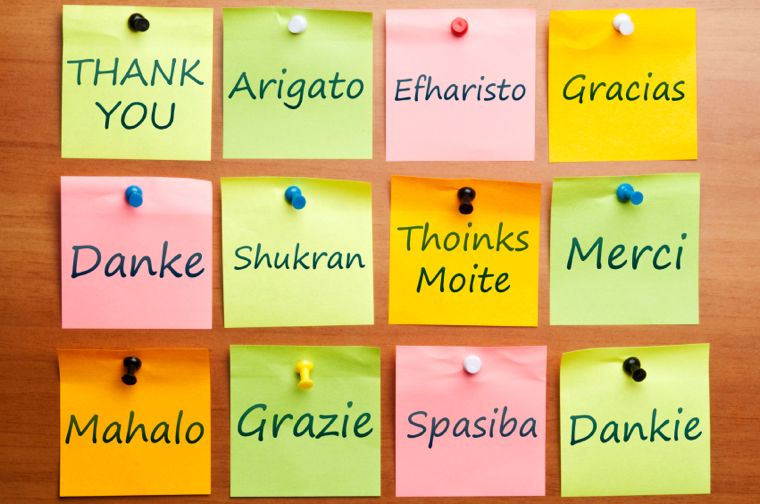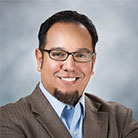
Californians speak many world languages, but not because the state's schools are good at teaching them to kids.
In This Lesson

How do Americans learn foreign languages?
How do students become bilingual?
When should children learn a second language?
Which languages are hardest to learn?
When and why did California ban language immersion classes?
Is foreign language an elective in California?
Will technology make language learning unnecessary?
When do students in other countries study world languages?
How can students earn the California Seal of Biliteracy?
▶ Watch the video summary
★ Discussion Guide
California's multilingual diversity has everything to do with the recent history of immigration.
Unfortunately, it has little to do with the education that children receive in schools.
For language learning, earlier is better
Research on language and brain development finds that until about age six or seven, children are “linguistic geniuses,” capable of discerning and reproducing the sounds of language with perfect fidelity and comparatively little effort.
Patricia Kuhl studies language acquisition, especially in babies. She has found that children learn the sounds of language very early, and that the aptitude for identifying the sounds of language declines sharply with age. Her TED Talk on the subject is well worth watching.
America has very low expectations for language learning
English is the world's most widely-spoken second language. Over a billion people in the world have learned to speak it, partly as a historic result of British imperialism and partly as a result of economic good fortune. America's unofficial, low-effort strategy for global communication has been "you learn English, then we can talk."
California requires zero years of world language instruction in elementary and middle school.
Learning a language takes time and effort at the right time of life. Unfortunately, few school systems in the US provide what it takes for students to become proficient in a language other than English. For most American children, mastery of a second language is simply not expected.
Few American students even have the option to learn world languages during their pre-teen years, when they are linguistic sponges. California requires zero years of world language instruction during elementary and middle school.
This is quite foolish.
Multilingualism is normal outside the USA
Outside the United States, multilingualism is ordinary. For example, most nations in Europe require foreign language instruction during several elementary and middle school grades.
Almost all countries in the European Union require foreign language study beginning in elementary school
Many countries that were once considered developing nations transformed their economies partly by making multilingualism a national educational priority. China, for example, transformed itself from being economically isolated to being vitally connected to the world market, including America. Students throughout China learn their local dialect as well as Mandarin and, more recently, English or other languages.
New language expectations for Americans
Many have argued that Americans need to learn how to communicate across a language barrier in order to keep up.
Brilliant young people from around the world learn English so they can apply to colleges in America. Historically, this inflow of talent has benefited the U.S. massively. However, countries around the world are improving their college programs. The case for students to come to the US for an expensive college education is becoming less clear. According to the U.S. State Department, what was once an almost totally one-way flow of students into the U.S. for college is now becoming more complex. Some young Americans are finding that it may make sense to learn other languages so that they can apply to excellent, less expensive colleges outside the U.S.
American students who cannot communicate in other languages may find their educational options constrained. For example, in 2021 the New York Times reported that China has begun to reverse gears in its strategy for international communication, with a greater expectation that others should learn to speak Mandarin, and Chinese students should redouble their focus on Chinese history and culture.
Will technology make language learning unnecessary?
Translating from one language to another was once a very difficult process involving big books printed in a tiny font. Today, it is already fairly easy to get a decent translation of nearly anything with the help of a smartphone or computer. In 2023 the Ed100 team began making consistent use of Artificial Intelligence (A.I.) to convert English material to Spanish. (Yes, a real human tweaks the final edits, but A.I. technology is very helpful in the process.)
For some, the rapid advance of language technology may reduce the motivational case for learning a language: Why do the hard work if my phone can translate for me whenever I need it?
For people who are motivated to learn a language, though, the tools for doing so are poised for big improvement. A.I. is rapidly improving its ability not only to translate, but to explain. In effect, every student will have access to a virtual tutor with full mastery of the language.
Some languages are harder than others, especially for adults
For American English speakers, some languages are more difficult to master than others. According to the Foreign Service Institute, which trains US diplomats, an average adult English speaker needs 600 hours to become proficient in many European languages including Spanish and Italian. More difficult languages take up to 2,200 class hours in their programs.
Among the languages that the institute categorizes as super-hard (yes, really), the thorniest of all for native English speakers is probably Japanese. The written language uses ideograms based on Chinese characters, but the characters can be pronounced in different ways depending on context. It also features nuances to express degrees of familiarity, humility and respect that confuse many Americans. (The Korean language shares this challenge, but has the advantage of an easy-to-learn writing system.)
It's worth acknowledging that this is a significant number of hours. For context, there are 180 days of instruction in a typical school year. Of course, young children can learn languages much quicker than aspiring diplomats can, if they feel motivated.
California's ambivalence to multilingualism
California's original 1849 state constitution was written in both English and Spanish, but public opinion has not always embraced multilingualism. In 1998, California voters rejected bilingual education by passing Proposition 227, which required that most classes in California public schools be taught in English. Voters overturned that initiative by passing another, Proposition 58, in 2016.
When California's ban on bilingual education ended, demand for multilingual teachers skyrocketed. School districts with large numbers of English Language Learners strained to offer more dual language learning opportunities, a topic we explore in the Ed100 blog.
The state's unclear stance toward multilingualism goes deeper. World language study is not required for high school graduation by the state of California — from the state's perspective it's an elective. But school districts have the authority to add their own graduation requirements, and many do so. Students who want to qualify for a public four-year college in California must find room in their class schedule to take at least two years of world language. Some California school districts split the difference, requiring one year.
The California Seal of Biliteracy
The state took a symbolic step to highlight the value of multilingualism by creating the nation's first State Seal of Biliteracy in 2008. Now available as an option in virtually all states, this program encourages districts to recognize high school graduates who have attained a high level of proficiency in speaking, reading, and writing one or more languages in addition to English.
In the 2023-24 school year, California recognized 72,027 students across 1,289 high schools with this seal — about 16% of diplomas. Many qualified students are missing out. The California Department of Education hopes to expand this number to 150,000 students through the Global California 2030 program. To request seals for graduating students at your school, ask your school district.
Call it world language, not foreign language.
America has a long history of "assimilating" immigrant groups, culturally and linguistically. Preserving the language skills that immigrant children bring with them has not been consistently viewed as important.
In 2018, California formally adopted the term "world language" in the education code. The change is meant to convey that no language is “foreign” in California.
Next Steps
Learn more from these sites:
- The California Association for Bilingual Education (CABE) provides great resources for parents and teachers.
- Some school districts in California have developed robust dual language pathways, including San Francisco Unified.
- Speaking in Tongues: 4 kids. 4 languages. 1 city. 1 world is a documentary that follows four San Francisco students as they become bilingual.
- The American Council on the Teaching of Foreign Languages offers tips for parents who want to advocate for language programs in their communities.
- Looking for ways to support your student learning a second language? Check out this article from GreatSchools.
- More research on the benefits of bilingualism from the New York Times: The Superior Social Skills of Bilinguals.
Updated January 2025
CHAPTER 6:
The Right Stuff
-
The Right Stuff
Overview of Chapter 6 -
Grade-Level Standards
What is the Common Core? -
Is School Challenging Enough?
Academic Rigor -
Literacy in California
Ensuring All Kids Can Read, Write and Speak English -
STEM Education in California
Science, Technology, Engineering and Math -
Why Are Tests Important?
Why Tests Matter and How They Work -
Technology in Education
Tools for Teaching and Learning -
Student Engagement
How to Make School Interesting -
Arts Education
Creativity in California Schools -
P.E. and School Sports
How Does Sweat and Movement Help Learning? -
Field Trips
Beyond the Classroom -
Career Technical Education
Vocational Learning, Dual-Enrollment, and Internships -
Service Learning
Civic Engagement and Helping Others -
Teaching Soft Skills
Social-Emotional Learning -
Can Values and Habits be Taught?
Character Education -
Civics, History and Geography
How Do Kids Learn About Their Country and the World? -
How do Kids Become Bilingual?
World Language Learning in California Schools -
Financial Literacy in California
Learning to Earn
Related
Sharing is caring!
Password Reset
Search all lesson and blog content here.
Login with Email
We will send your Login Link to your email
address. Click on the link and you will be
logged into Ed100. No more passwords to
remember!















Questions & Comments
To comment or reply, please sign in .
Carol Kocivar August 12, 2025 at 6:01 pm
Our new report, Ensuring a Multilingual-Ready UPK Workforce, draws on the work of the English Learners Workforce Investment Initiative (EL-WIN) to provide practical strategies for strengthening the educator pipeline and ensuring developmentally appropriate, culturally affirming instruction for multilingual learners.
https://californianstogether.org/resource/ensuring-a-multilingual-ready-upk-workforce/?mc_cid=e33fe4b57f&mc_eid=0407b36afa
Carol Kocivar April 12, 2025 at 6:21 pm
"As of 2019–20, California enrolled roughly 1 in 6 of its more than 1 million ELs in some form of bilingual education or dual-language immersion—the models that research suggests are best for these students. This ranks California well behind its peers—both EL-rich states like Texas and Illinois and less linguistically diverse states like Wisconsin and Alaska.
As we note in the report, this is partly driven by a shortage of state funding for bilingual and dual-language programs. California’s single $10 million dual-language immersion grants competition is nowhere near large enough to keep pace with other states"
-- From LA School Report
Jeff Camp - Founder June 29, 2023 at 6:42 am
Carol Kocivar June 14, 2022 at 6:03 pm
The report linked below shows the comparison with other states as well as proficiency levels required to qualify.
https://sealofbiliteracy.org/doc/2020-National-Seal-of-Biliteracy-Report-Final.pdf
David Siegrist1 October 12, 2021 at 5:05 pm
David Siegrist1 October 12, 2021 at 4:57 pm
Sheila Melo May 29, 2020 at 1:49 pm
Carol Kocivar March 31, 2019 at 2:32 pm
Blog
Susannah Baxendale February 17, 2019 at 12:46 pm
Carol Kocivar January 14, 2018 at 9:08 am
The Atlantic
Lisette October 3, 2017 at 4:38 pm
Carol Kocivar December 27, 2016 at 3:08 pm
http://www.npr.org/sections/ed/2016/11/29/497943749/6-potential-brain-benefits-of-bilingual-education?
Carol Kocivar October 15, 2016 at 11:50 am
The choices in the review question above will be modified to add one more option.
That option will be 4. zero. Then you will be able to select the right answer.
Pepe October 12, 2016 at 10:37 pm
After reading the lesson I would like to know what the correct answer is
Jeff Camp - Founder March 3, 2016 at 11:49 am
Angelica Manriquez February 29, 2016 at 6:40 pm
Julissa Salamanca March 27, 2015 at 12:28 pm
Paul Muench January 18, 2015 at 7:13 am
Gavin Payne June 2, 2011 at 3:00 pm